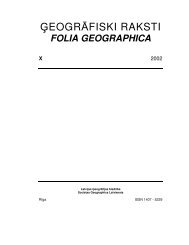eogrÄfiski raksti folia geographica xii - Ä¢eogrÄfijas un Zemes zinÄtņu ...
eogrÄfiski raksti folia geographica xii - Ä¢eogrÄfijas un Zemes zinÄtņu ...
eogrÄfiski raksti folia geographica xii - Ä¢eogrÄfijas un Zemes zinÄtņu ...
Create successful ePaper yourself
Turn your PDF publications into a flip-book with our unique Google optimized e-Paper software.
Pre-spring (PSP): second half of February to end of March;<br />
Early spring (ESP): end of March to middle of April;<br />
Full spring (FSP): middle of April to first half of May;<br />
Pre-summer (PS): first half of May to beginning of J<strong>un</strong>e;<br />
Early summer (ES): beginning of J<strong>un</strong>e to end of J<strong>un</strong>e;<br />
High summer (HS): end of J<strong>un</strong>e to end of July;<br />
Late summer (LS): end of July to end of August;<br />
Early autumn (EA): end of August to second half of September;<br />
Full autumn (FA): second half of September to end of October;<br />
Pre-winter (PW): end of October to end of November.<br />
29<br />
NATURE RESEARCH<br />
The criteria of such division were pointed at and justified in the preceding discussion and<br />
figures. However, to complete this part of work, it might be appropriate to emphasize some<br />
conclusions which yet need to be studied in greater detail. They are as follows: (1) each season<br />
may be distinguished by a definite pattern of solar radiation, distinctive state of heat and water<br />
balance, biological turnover, phenological state of vegetation; (2) during each season these<br />
variables show a particular combination on numerical values and a distinctive landscape image;<br />
(3) every season has an effect on the state of landscape in the following seasons (theoretically –<br />
throughout the year); (4) transitions between the seasons are both gradual and sharp, but in all<br />
cases these may be clearly identified by several quantitative and qualitative features.<br />
From this chapter it also follows that differences between seasons may be related to air<br />
mass occurrence (Figure 6). Since air mass types and their frequency is a factor which has been<br />
left beyond the scope in landscaper research, two following chapters are devoted to this item.<br />
4. Air mass occurrence<br />
4.1. Air mass types<br />
Latvia’s atmosphere in the context of air masses is related to other parts of Europe and<br />
the northern hemisphere in general, and experiences day-to-day, as well as seasonal, changes.<br />
Following M.Geb’s (1981) classification, air masses were ranked according to their heat<br />
content. In addition to the determined backward trajectory, the typical 850 hPa temperature and<br />
pseudopotential temperature were considered (Figures 7, 8). At the same time the air masses<br />
arriving in Latvia were described in relation to their source region and some typical weather<br />
conditions [Draveniece 2003].<br />
4.2. Seasonal changes of air masses<br />
Based on the 850 hPa temperature and pseudopotential temperature, the monthly mean<br />
values for a 11-year (1990-2000) period were fo<strong>un</strong>d. These might describe the average or<br />
theoretical air mass in Latvia.<br />
From October to March, the average air mass was transformed maritime subpolar air xP.<br />
However, the average October air mass could hardly be distinguished from mP air. Regarding<br />
the heat content, the corresponding temperatures take up an intermediate position between the<br />
xP and mP air, so the decisive role was attached to moisture content. This finding fits in with<br />
the mapping of European air mass source regions in winter drawn by M.Geb (1981). The xP is a<br />
relatively temperate air in winter months and usually produces a sheet-like or layered (stratus)<br />
cloud cover the entire sky. It commonly occurs when warm, moist mP air moves over cold<br />
gro<strong>un</strong>d surface during winter. Stratus clouds produce little precipitation, usually in the form of<br />
drizzle. Occasionally, xP may produce partly cloudy or fair weather, depending on the degree of<br />
transformation.

















